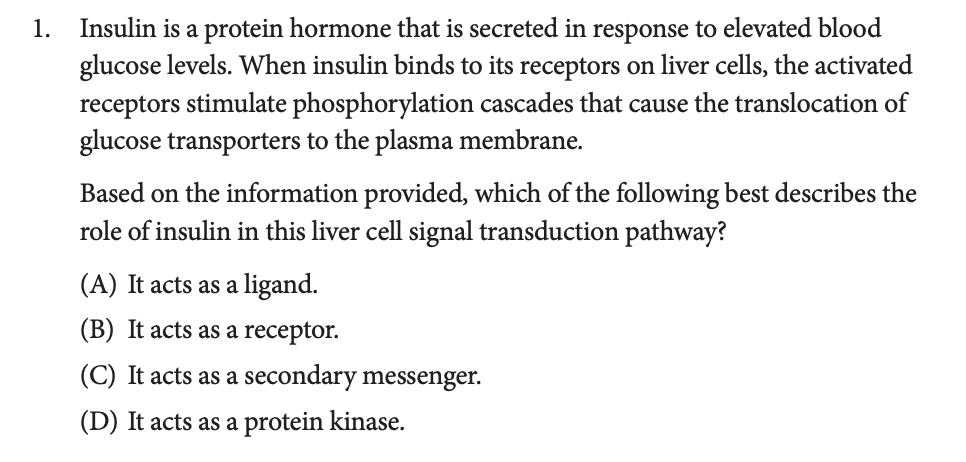Ultimate Guide to the AP Biology Exam
The AP Biology exam is one of the most popular exams; in 2019, 260,816 students took the AP Biology exam. If you’re planning to take the AP Bio exam, whether you have taken the class or self-studied, read on for a breakdown of the test and CollegeVine’s advice for how to best prepare. The 2020 AP Exams have been changed to online exams due to coronavirus. Learn about these changes in our post How is Coronavirus Impacting AP Exams? At a high level, taking the AP prepares you to engage with scientific inquiry in four ways: You will gain these skills over the course of an 8-unit curriculum. You can keep reading for a unit-by-unit summary of a typical AP Biology class, or jump to the next section for details on test format. Exam Coverage: 8–10% of the test Water forms the basis of all life. Learn about its chemical properties as well as the functions of macromolecules like lipids, proteins, and carbohydrates. This unit also covers the structure of RNA and DNA. Exam Coverage: 10–13% of the test In this unit, you will cover the anatomy of a cell and the fundamentals of evolution. Learn the cell components and their functions. Focus on a cell’s interaction with its environment, including the membrane’s structure and functions. Exam Coverage: 12–16% of the test Discover how cells’ fundamental processes generate, store, and use energy. Learn about the structure and function of enzymes, process of photosynthesis, and cellular respiration among other topics. Exam Coverage: 10–15% of the test In other words, Unit 4 focuses on reproduction, growth, and information transmission of cells. Learn about the main events in a cell cycle and explore feedback mechanisms that ensure healthy functioning. Exam Coverage: 8–11% Organisms can pass their traits on to the next generation via meiosis and asexual reproduction. In this unit, you will learn how these processes work, the history of genetic research, the importance of genetic diversity, and the myriad factors that impact how a gene is expressed. (If you like chi squares, you’ll love Unit 5.) Exam Coverage: 12–16% Explore some of the same concepts in Unit 5 at the molecular level. Learn the roles and functions of DNA and RNA, along with specific mechanisms of gene expression. Discuss mutations, genetic diversity, natural selection, and biotech. Exam Coverage: 13–20% In Natural Selection, you’ll learn Darwin’s Theory of Evolution, exploring the concepts of natural selection, evidentiary support for evolution, and various factors that lead to microevolution and speciation. This is also the unit that covers the origin of life on Earth. Exam Coverage: 10–15% Explore larger organisms and how populations engage with their ecosystems. Study community, population growth, and ecosystem dynamics, with a focus on how environmental changes shift an ecosystem’s equilibrium. For an even more thorough run-down of all content covered on the AP exam, be sure to read the College Board’s AP Biology Course Description. The AP Biology exam format was updated in 2020. It contains two 90-minute sections, and your score on each comprises exactly half of your overall raw score. Below you can find an accurate, up-to-date summary of the test format. For those of you familiar with the former AP Biology test structure, all grid-in questions on the Multiple Choice Section have been removed. Additionally, two of the short-answer questions have been removed from the Free Response Section. Multiple Choice (2) Analyze diagrams, flow charts, and other visual representations (3) Use the scientific method (4) Perform mathematical calculations to analyze data (5) Support scientific claims with evidence Free Response (2) Graph and analyze data (3) Understand the principles and procedures of lab investigations (4) Predict the causes or effects of a change in a biological system (5) Analyze a visual representation of a biological phenomenon You can earn a passing score on the AP Biology exam by scoring a 3 or higher on test day. Roughly 65% of students who took the test last year passed. The average score on the AP Bio exam for 2019 was a 2.92. For more information on AP exam score distributions, check out our post on the easiest and hardest AP Exams. In order to understand the material in the AP Biology course, you’ll need to understand the structure of the course outline, available in the in-depth course description. The outline organizes key concepts into four “big ideas” that you will need to comprehend completely. You will need to learn all of the underlying content in the outline. Additionally, be sure to make connections across content and concepts while you’re learning. Your success on the exam will depend on your ability to think critically and conceptually about big ideas and the enduring understandings that relate to them, while using illustrative examples to emphasize your points. You will also need to master seven scientific practices. To do this, you should be familiar with the provided lab manual. The course recommends that teachers spend 25% of class time on labs, with at least two labs per big idea. The College Board specifies that in a lab exploration, you should be able to: For a more specific idea of where to focus your studying, you may consider using an updated commercial study guide. Because the AP Biology course was so recently redesigned, there are not yet many choices of updated commercial study guides. The Princeton Review’s 2020 Edition of their AP Biology manual is a great place to start. Remember though, no prep book compares to your textbook. They may have great practice tests, but they won’t cover the material as intensively. Take a practice test to assess your initial knowledge of the material. Although the College Board AP Biology website provides a number of sample test questions and exam tips, it does not provide a complete sample test with the new format. Because the exam was so recently redesigned, it can be difficult to find updated practice tests. Your best bet is to use those provided in one of the many commercial study guides. Alternatively, you can take the 2013 AP Biology Practice Exam, released by the College Board. Once you have taken some kind of formative assessment, score it to identify the areas you already understand and those in need of improvement. It can be helpful to have a friend or teacher help to score your free response essays, as these are more subjective than the multiple choice section. From an accurate formative assessment, you will get a better idea of where to focus your studying efforts. The AP Bio exam is definitely term-heavy, which can be a blessing in disguise. Most of the time, if you can accurately explain every key term that is bolded in your textbook, you have a solid grasp of the concepts and systems underlying them. To give just one example, take a look at this practice question from the 2020 AP Course Description: This question is almost entirely vocabulary-in-action. To break down the question, our first sentence informs us that insulin is a protein released into blood with high levels of glucose. Next, we learn that insulin binds to liver cell receptors, which trigger molecule transfer by moving parts of the glucose molecules to the cell wall. Next, let’s assume you have memorized the following definitions: Which of these terms describes the role insulin is playing in the exchange? It cannot be B because we learn insulin was released into the region. That means it cannot be a receptor receiving information, since it has not been there all along. We can also eliminate C because the question states insulin is the hormone, not something released by the hormone. A and D are our most compelling options, since we know that we have both a ligand and a protein kinase at work. However, a closer look at the question reveals that the receptors are acting as the kinase, not the insulin. The correct answer is A. For you to have ownership over these complex technical terms, you have to put in the effort throughout the year to master it. In the back of your notebook or in a separate document in your AP Biology folder, create a running list of key terms that give you trouble in each unit. Once a week, or at the very least once a month, spend half an hour reviewing this list to shore up your knowledge. Yes, weekly review requires a bit of forethought and prior planning. However, the time you put in regularly will dramatically reduce how much content you forget as you move swiftly through your course. Because the base of scientific knowledge is so rapidly expanding through discovery and research, the AP Biology course focuses on lasting conceptual understandings within the field, and the specific content that supports them. Students spend less time on factual recall and more time on inquiry-based learning of essential concepts along with the development of reasoning skills. Nowhere is this approach more apparent than on the free-response section. Given any set of evidence, even data that you have never seen previously, can you engage in scientific inquiry? Can you evaluate what you are being shown and come to new conclusions? Let’s break down this process with an example short-answer question: You should allot no more than 10 minutes for each short-answer question. (We recommend 20–5 minutes for long-responses and 8-10 minutes for short-answer questions, leaving you with –10 minutes to check your work.) Allot 90 seconds to read the question thoroughly. Perhaps spend 60 seconds on the words and 30 seconds on the two figures. Answer the questions in order, as later sub-bullets often assume you have resolved all prior sub-questions first. I will only give myself one minute to answer the “Describe” question, since that simply requires me to explain a process I have learned about in class. Building off of my explanation of meiosis in part A, answering part B merely consists of adding a 1-2 sentence addendum to my earlier point. I doubt answering this question will take me more than a minute. Take two minutes to answer part C, since it requires lining up notation with specific aspects of the figure provided. Since this question requires me to integrate my prior knowledge with the problem, I am giving myself more time than I did for the sub-bullets that were merely fact recall. Part D is far and away the most difficult section of this short-answer question, since it requires coming to a conclusion by considering all the data available. I will give myself three minutes to answer this question. Later, when I proofread my answers, I will spend most of that time carefully reviewing the trickiest sub-bullets of each question. Consider starring questions like Part D as you go so you know exactly which questions gave you the most trouble. Make sure you answer both aspects of the prompt: (1) Is the condition sex-linked our autosomal? (2) Is it dominant or recessive? In this case, because both men and women express this gene, we know it is autosomal. Because some children whose parents do not express the gene still express it themselves (See 14), we know the gene is recessive. That answer is sufficient for part D, and you will notice that it is not longer than answers you would expect to give for the other sub-bullets. Rather, taking time to scrutinize the figure is what took up time for that question. To review, you should spend roughly 20-25 minutes on each long answer and 8-10 minutes on each short answer. Leave yourself with 5-10 minutes at the end to review the Free Response Section in its entirety. Though you will be reminded of time remaining by the exam proctor, you will not be forced to move on from question to question. For that reason, practicing pacing is critical. Make sure you stay on track to address each section of every question. No points can be awarded for answers left completely blank when time runs out. That’s everything we think you need to know to get started studying for the AP Biology Exam! To review, pay close attention to your textbook, use practice tests as a way to familiarize yourself with the format, review vocabulary frequently to stay on top of concepts, and pay attention to pacing as you answer some of the more open-ended free response questions. Want access to expert college guidance—for free? When you create your free CollegeVine account, you will find out your real admissions chances, build a best-fit school list, learn how to improve your profile, and get your questions answered by experts and peers—all for free. Sign up for your CollegeVine account today to get a boost on your college journey. For more about information about APs, check out these CollegeVine posts: When is the AP Biology Exam?
What Does the AP Biology Exam Cover?
Unit 1: Chemistry of Life
Unit 2: Cell Structure and Function
Unit 3: Cellular Energetics
Unit 4: Cell Communication and Cell Cycle
Unit 5: Heredity
Unit 6: Gene Expression and Regulation
Unit 7: Natural Selection
Unit 8: Ecology
How Long is the AP Bio exam? What is the Format?
Section
Duration
Questions
Skills
Section 1:
1 hour, 30 minutes
60 multiple-choice questions
(1) Explain biological concepts, processes, and models
Section 2:
1 hour, 30 minutes
6 questions: 2 long-response and 4 short-answer questions, one of which requires graphing
(1) Interpret and evaluate results from an experiment
AP Biology Score Distribution, Average Score, and Passing Rate
2019 Exam
5
4
3
2
1
AP Biology
7.2%
22.2%
35.3%
26.6%
8.8%
Best Ways to Study for the AP Biology Exam
Step 1: Study the material in depth.
Step 2: Take practice exams to get experience with the new test format.
Step 3: Keep a running list of tricky key terms, and revisit it frequently.

Step 4: Practice free-response questions in a timed setting.






